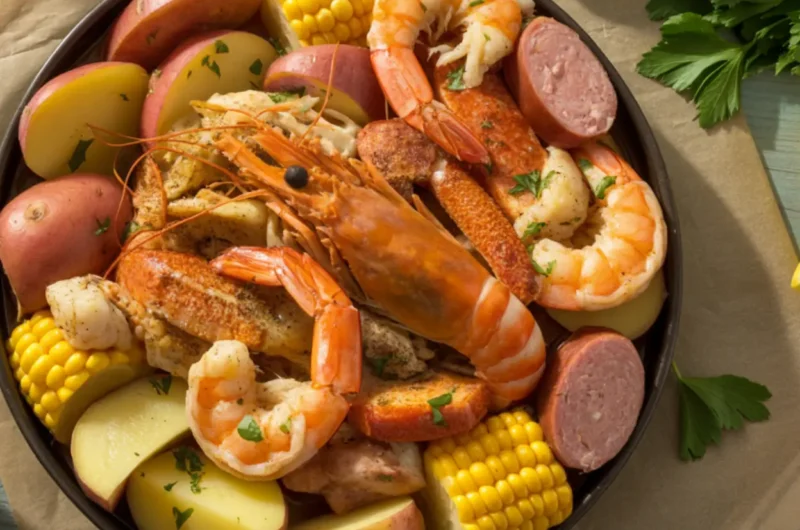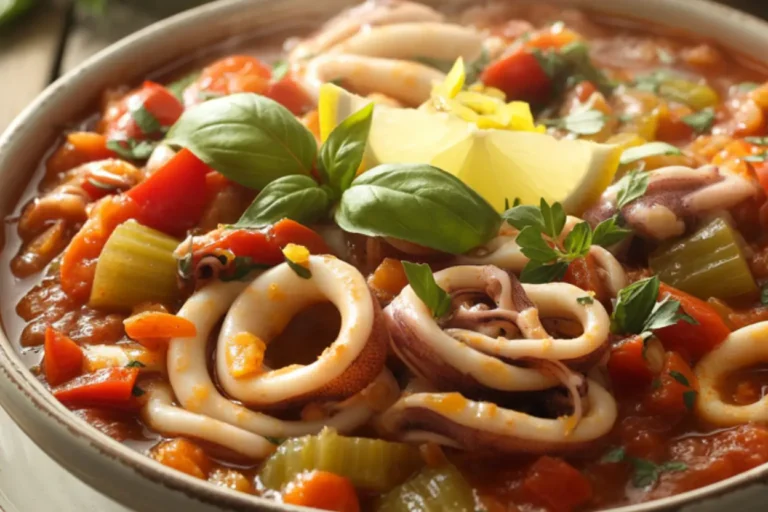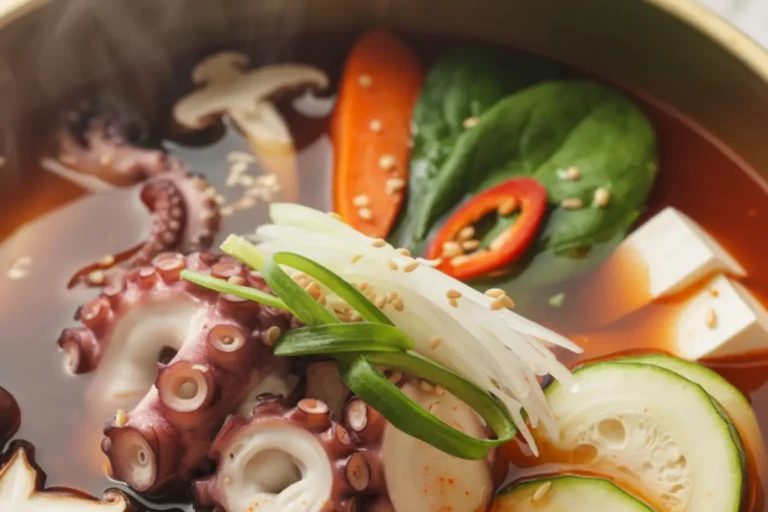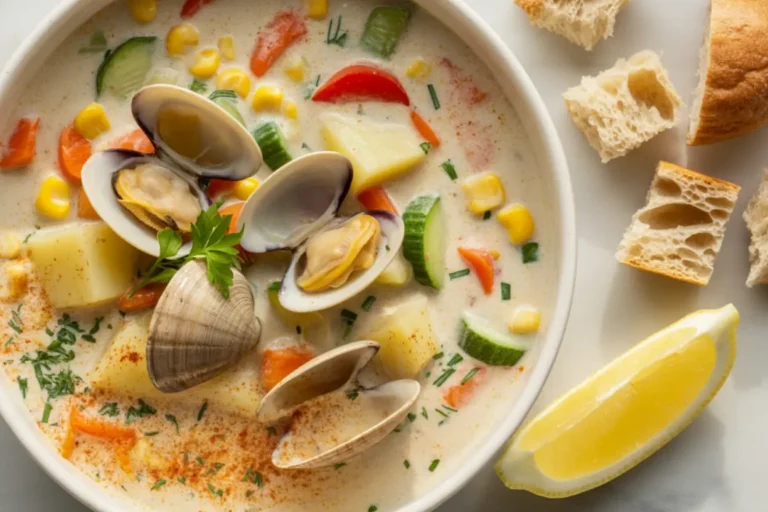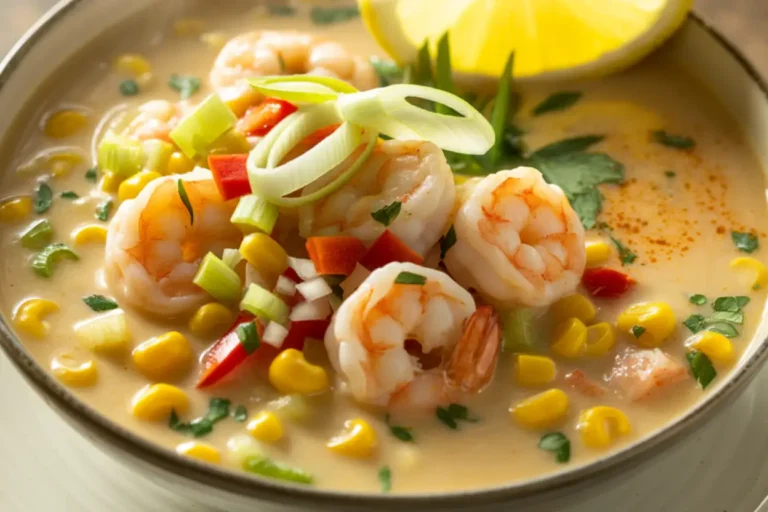Frogmore Stew: 5 Steps to a Southern Seafood Classic
Table of Contents
Despite its name, Frogmore Stew contains no frogs and isn’t exactly a stew in the traditional sense. This iconic Low Country boil represents Southern coastal cooking at its finest—combining fresh seafood, smoky sausage, sweet corn, and tender potatoes in a perfectly seasoned broth. As someone who’s been perfecting this one-pot wonder for over a decade, I’m excited to share my definitive guide to creating authentic Frogmore Stew that will transport you straight to the Carolina coast.
Thank you for reading this post, don't forget to subscribe!Whether you’re hosting a backyard gathering or looking for an impressive yet straightforward meal to feed a crowd, this Frogmore Stew recipe delivers big flavors with minimal fuss. Let me show you how to master this Southern classic in just five simple steps.
How to Make Frogmore Stew
Quick Overview
Frogmore Stew (also known as Low Country Boil) exemplifies the beauty of Southern coastal cuisine—it’s unpretentious, abundantly flavorful, and designed for communal enjoyment. What makes this dish so special is its perfect balance of land and sea ingredients, all infused with a zesty, aromatic broth that enhances each component without overwhelming it.
The genius of Frogmore Stew lies in its straightforward cooking method and the thoughtful layering of ingredients. By adding each element at precisely the right moment, everything finishes cooking simultaneously, resulting in tender seafood, perfectly done vegetables, and sausage that’s infused the entire pot with its savory essence.
Despite its impressive presentation when dramatically poured out onto a newspaper-covered table, this one-pot feast requires minimal technical skill—just attention to timing. The resulting medley of textures and flavors creates a memorable dining experience that embodies the spirit of Southern hospitality. Best of all, the entire meal comes together in under an hour, making it perfect for both weeknight family dinners and weekend entertaining.
The Ingredients I Use to Bring My Frogmore Stew to Life
For the Seasoned Broth Base:
- 4 quarts of water
- 1/4 cup Old Bay seasoning
- 3 tablespoons kosher salt (adjust based on Old Bay variety – some contain more salt than others)
- 2 tablespoons whole black peppercorns
- 6 bay leaves
- 2 lemons, halved
- 1 large yellow onion, quartered (skin left on for color and flavor)
- 8 cloves garlic, peeled and lightly crushed
- 2 tablespoons smoked paprika
- 1 tablespoon cayenne pepper (adjust to taste for heat preference)
- 2 teaspoons celery seeds
Main Ingredients (in order of cooking):
- 2 pounds small red potatoes, halved if larger than 2 inches
- 1 pound smoked turkey sausage, cut into 3-inch pieces
- 6 ears fresh corn, shucked and broken into 3-inch pieces
- 2 pounds large shrimp (21-25 count), shell-on and deveined
- 2 pounds fresh crab legs, pre-cooked and cracked (optional but traditional)
For Serving:
- 1/4 cup fresh parsley, chopped
- 2 lemons, cut into wedges
- Hot sauce to taste
- Melted butter for dipping (optional)
Special Equipment:
- Large stock pot (at least 12-quart capacity)
- Slotted spoon or spider strainer
- Colander
- Large serving platter or newspaper-covered table for traditional presentation
Step-by-Step Instructions
Step 1: Prepare the Flavorful Broth Base
- In a large stock pot (at least 12-quart capacity), combine the 4 quarts of water, Old Bay seasoning, kosher salt, peppercorns, bay leaves, smoked paprika, cayenne pepper, and celery seeds.
- Squeeze the juice from the halved lemons into the pot, then add the squeezed lemon halves as well. These will continue to release oils and flavor as they cook.
- Add the quartered onion and crushed garlic cloves to the broth.
- Bring the mixture to a rolling boil over high heat, then reduce to a simmer and cook for 15 minutes to allow the flavors to infuse into the broth. This step is crucial—don’t rush it, as this flavored broth is the foundation of your Frogmore Stew.
- After simmering, taste the broth and adjust seasonings if needed. It should taste well-seasoned and somewhat spicy, as these flavors will be diluted once absorbed by the other ingredients.
Step 2: Add the Potatoes and Sausage
- Once your broth has simmered for 15 minutes, return it to a rolling boil over high heat.
- Add the halved red potatoes to the boiling broth. Make sure they’re all submerged in the liquid. Cover the pot and cook for 10 minutes, or until the potatoes are just beginning to become tender when pierced with a fork but are not yet fully cooked.
- Add the smoked turkey sausage pieces to the pot with the partially cooked potatoes. The sausage will release additional flavor into the broth as it heats through.
- Return the pot to a boil, then reduce to a steady simmer. Cook the potatoes and sausage together for an additional 5 minutes. At this point, the potatoes should be about halfway done.
Step 3: Add the Corn
- Add the corn pieces to the pot with the potatoes and sausage. Ensure everything is submerged in the flavorful broth, adding a bit more water if necessary.
- Return to a boil, then reduce to a simmer and cook for an additional 5-7 minutes until the corn is beginning to become tender and bright yellow.
- At this stage, test a potato piece to gauge doneness. It should be almost fully tender but still have a slight resistance in the center. If the potatoes are already fully tender, reduce the remaining cooking time slightly to avoid overcooking.
Step 4: Add the Seafood
- Add the shell-on shrimp to the pot, pushing them down into the broth to ensure they’re fully submerged.
- If using crab legs, add them to the pot at the same time as the shrimp. Since most crab legs come pre-cooked, they just need to be heated through.
- Cook for just 3-4 minutes until the shrimp have turned pink and opaque. Be careful not to overcook, as shrimp can become tough and rubbery very quickly.
- Once the shrimp are just cooked through, immediately remove the pot from the heat. The residual heat will continue cooking everything for a few minutes.
Step 5: Drain and Serve
- Using a slotted spoon or spider strainer, transfer the solid ingredients to a large colander to drain briefly. Alternatively, you can drain everything at once, but reserve about 1 cup of the cooking liquid for serving.
- For a traditional presentation, spread a newspaper across your table and pour the drained Frogmore Stew directly onto it. For a more formal presentation, arrange everything on a large serving platter.
- Sprinkle the fresh chopped parsley over the top and arrange lemon wedges around the edges.
- Serve immediately with small bowls of the reserved cooking broth and melted butter for dipping, and bottles of hot sauce for those who enjoy additional heat.
- For authentic Low Country dining, no plates or utensils are needed—just plenty of paper towels and perhaps bibs for the enthusiastic eaters!
What to Serve Frogmore Stew With
While Frogmore Stew is essentially a complete meal on its own, a few carefully chosen accompaniments can elevate the experience:
Bread Options:
- Warm, crusty French bread for sopping up the flavorful broth
- Buttery garlic bread
- Traditional Southern cornbread
- Old Bay seasoned oyster crackers
Lighter Side Dishes:
- Simple green salad with vinaigrette to cut through the richness
- Tangy coleslaw with a vinegar-based dressing
- Cucumber and tomato salad with fresh herbs
- Pickled vegetables like okra or green tomatoes
Sauces and Condiments:
- Drawn butter with lemon
- Homemade cocktail sauce
- Remoulade sauce
- Additional Old Bay seasoning for tableside sprinkling
- Various hot sauces for customizable heat levels
Beverage Pairings:
- Cold sweet tea (an authentic Southern choice)
- Light lagers or pilsners
- Crisp white wines like Sauvignon Blanc
- Sparkling lemonade
- Arnold Palmers (half lemonade, half iced tea)
Dessert Suggestions:
- Key lime pie
- Peach cobbler
- Banana pudding
- Lemon bars
- Fresh berries with whipped cream
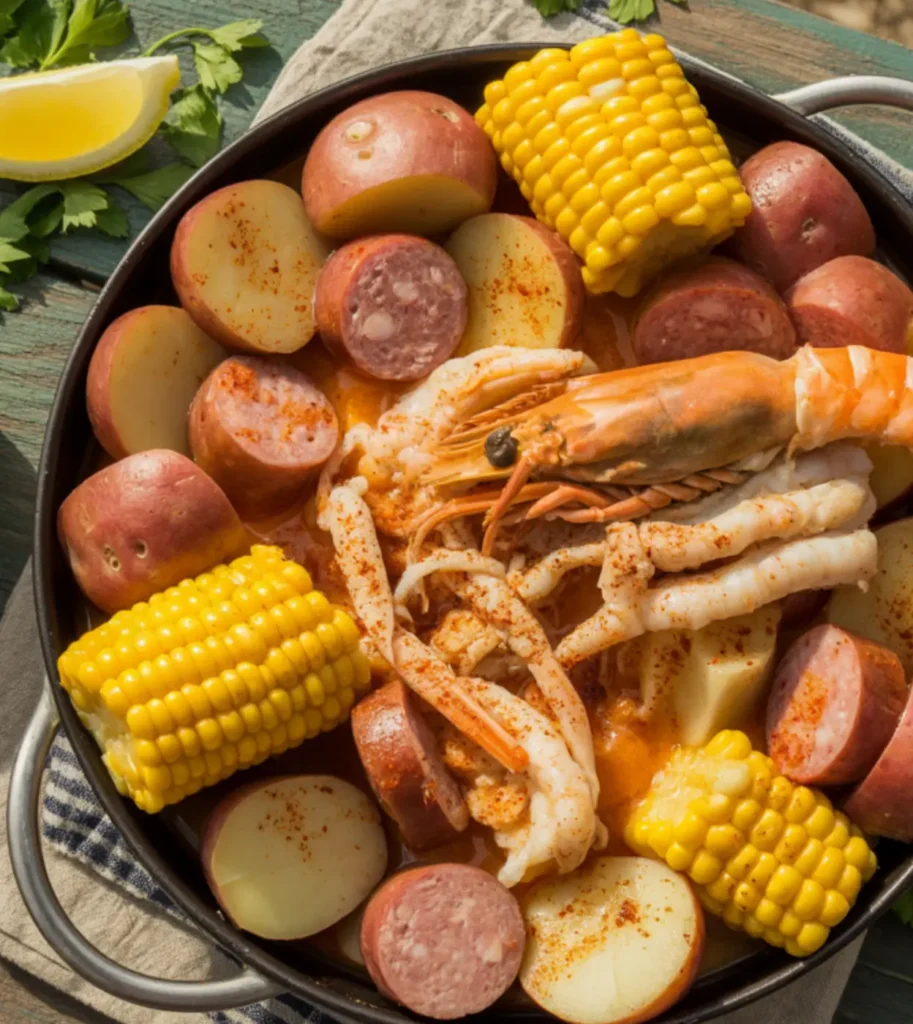
Top Tips for Perfecting Frogmore Stew
Tip #1: Master the Art of Ingredient Timing
The key to perfect Frogmore Stew lies in understanding how each ingredient cooks:
- Stagger additions based on cooking time: The sequence of adding ingredients is non-negotiable—potatoes first, then sausage, corn, and finally seafood.
- Test doneness of potatoes frequently: They’re the barometer for how your timing is progressing. They should be fork-tender but not falling apart when the dish is done.
- Never overcook the seafood: Shrimp cook extremely quickly—they only need 3-4 minutes in boiling liquid. Once they turn pink and opaque, they’re done.
- Consider size variations: If using extra-large shrimp, they may need an additional minute. If using baby potatoes, they might cook more quickly.
- Use visual cues: Corn brightens in color, shrimp curl and turn pink, potatoes yield easily to a fork—these visible changes are more reliable than strict timing.
Tip #2: Perfect Your Broth Base
The flavored broth is what transforms this from a simple boil to an exceptional dish:
- Don’t rush the initial simmer: Those 15 minutes of simmering the aromatics before adding any main ingredients are crucial for developing depth of flavor.
- Taste before adding main ingredients: The broth should taste quite strongly seasoned, as the potatoes and other ingredients will absorb much of that flavor.
- Customize the heat level: The cayenne pepper can be adjusted up or down based on your preference. Remember that heat intensifies as the broth reduces.
- Use whole spices where possible: Whole peppercorns and bay leaves infuse flavor without making the broth gritty.
- Old Bay alternatives: If Old Bay isn’t available, create your own blend with 1 tablespoon paprika, 1 teaspoon each of celery salt, black pepper, and dry mustard, plus 1/2 teaspoon each of ground bay leaves, cayenne pepper, ground cloves, and ground allspice.
Tip #3: Select and Prepare Seafood Wisely
The star ingredients deserve special attention:
- Use shell-on shrimp: They contribute more flavor to the broth and are protected from overcooking by their shells.
- Devein but leave shells: Having the shrimp deveined but shell-on offers the best of both worlds—better flavor and easier eating.
- Pre-crack crab legs: If using crab legs, crack them slightly before adding to the boil so they absorb more flavor.
- Consider regional variations: In some areas, adding cleaned mussels or clams for the last 5 minutes is traditional.
- Freshness matters: The quality of your seafood dramatically impacts the final result. Use the freshest available or high-quality frozen seafood properly thawed.
Tip #4: Presentation Makes a Difference
The traditional serving style enhances the experience:
- Newspaper service: For an authentic presentation, cover your table with several layers of newspaper or brown kraft paper.
- Dramatic pour: The theatrical pouring of the Frogmore Stew onto the center of the table is part of the experience—just make sure to drain it well first!
- Communal eating: The shared, hands-on nature of the meal is part of its charm. Embrace the casual, communal aspect.
- Strategic arrangement: Place larger items like crab legs around the perimeter, with smaller items like shrimp and corn in the center for an impressive visual impact.
- Color enhancement: Arrange lemon wedges and sprinkle fresh parsley over the top just before serving for vibrant color and fresh flavor.
Tip #5: Adapt for Different Occasions and Dietary Needs
Frogmore Stew can be customized without losing its essence:
- Scaling up or down: The recipe multiplies easily for crowds—just maintain the ratio of ingredients and ensure your pot is large enough.
- Individual portions: For a more formal dinner, serve in large bowls with some of the broth.
- Seafood allergies: The dish works beautifully even without the seafood—the sausage, potatoes, and corn with the flavorful broth are delicious on their own.
- Make ahead strategy: Prepare the broth base up to a day ahead and refrigerate. Reheat to a boil before adding ingredients.
- Heat level adjustments: Create a milder version for mixed company by reducing the cayenne and offering hot sauce at the table.
Storing and Reheating Tips
Although Frogmore Stew is best when served fresh, you can still enjoy the leftovers by following these simple tips:
Storage Guidelines:
- Separate components: For best results, store the seafood separately from the potatoes, corn, and sausage.
- Seafood storage: Place leftover seafood in an airtight container and refrigerate for up to 2 days. Seafood quality degrades quickly, so consume as soon as possible.
- Vegetables and sausage: You can store these ingredients together in an airtight container in the refrigerator for up to 3 to 4 days.
- Broth preservation: If you reserved any of the cooking broth, store it separately in the refrigerator for up to 3 days. This flavorful liquid is excellent for reheating or as a base for seafood soups.
Reheating Methods:
- Gentle Stovetop Reheating (Best Method):
- Heat a small amount of the reserved broth or water in a skillet.
- Add the potatoes, corn, and sausage first, warming over medium-low heat for 3-4 minutes.
- Add the seafood last, cooking just until heated through (1-2 minutes maximum) to avoid overcooking.
- Oven Method (Good for Larger Portions):
- Preheat oven to 350°F.
- Place potatoes, corn, and sausage in a baking dish and cover with foil.
- Heat for 10 minutes, then add seafood and heat for an additional 5 minutes only.
- Microwave Method (Quick but Less Ideal):
- Place a portion in a microwave-safe dish with a tablespoon of water or broth.
- Cover with a damp paper towel.
- Heat at 50% power in 30-second intervals, stirring between each.
- Add seafood only for the final 30 seconds to prevent a rubbery texture.
Freezing Options (Limited):
- Seafood components: Not recommended for freezing after cooking, as the texture significantly deteriorates.
- Potatoes, corn, and sausage: Can be frozen for up to 1 month, though potatoes may change texture somewhat upon thawing.
- Broth: Freezes well for up to 3 months and can be used as a flavorful base for future seafood dishes.
Creative Leftover Ideas:
- Frogmore Breakfast Hash: Dice the leftover potatoes, corn, and sausage, then sauté them in a little butter. Add a fried egg on top for a tasty and satisfying breakfast.
- Seafood Salad: Chop leftover seafood and toss with mayonnaise, lemon, celery, and herbs for a quick seafood salad sandwich.
- Corn Chowder: Turn the leftover corn, potatoes, and broth into a quick and easy corn chowder — a perfect way to repurpose your Frogmore Stew.
- Seafood Fried Rice: Incorporate chopped leftover components into a flavorful fried rice dish.
By following these detailed instructions and expert tips, you’ll create a Frogmore Stew that captures the essence of Southern coastal cuisine. This beloved one-pot feast brings together the bounty of land and sea in a celebration of flavor that’s meant to be shared. Whether you’re a Low Country native or experiencing this classic for the first time, the combination of perfectly cooked seafood, smoky sausage, sweet corn, and tender potatoes in a zesty broth creates an unforgettable meal that’s sure to become a tradition in your home.
Frogmore Stew: 5 Steps to a Southern Seafood Classic
Cuisine: AmericanDifficulty: Easy6
servings20
minutes35
minutes450–550
kcalFrogmore Stew, also known as Lowcountry Boil, is a classic Southern seafood boil loaded with bold spices, tender shrimp, smoked sausage, red potatoes, and fresh corn. It’s a one-pot wonder meant for casual gatherings and coastal feasts, often served family-style on a large table with plenty of napkins and cold drinks.
Ingredients
4 quarts of water
1/4 cup Old Bay seasoning
3 tablespoons kosher salt (adjust based on Old Bay variety – some contain more salt than others)
2 tablespoons whole black peppercorns
6 bay leaves
2 lemons, halved
1 large yellow onion, quartered (skin left on for color and flavor)
8 cloves garlic, peeled and lightly crushed
2 tablespoons smoked paprika
1 tablespoon cayenne pepper (adjust to taste for heat preference)
2 teaspoons celery seeds
2 pounds small red potatoes, halved if larger than 2 inches
1 pound smoked turkey sausage, cut into 3-inch pieces
6 ears fresh corn, shucked and broken into 3-inch pieces
2 pounds large shrimp (21-25 count), shell-on and deveined
2 pounds fresh crab legs, pre-cooked and cracked (optional but traditional)
1/4 cup fresh parsley, chopped
2 lemons, cut into wedges
Hot sauce to taste
Melted butter for dipping (optional)
Directions
- Build the Flavorful Broth
In a large stock pot, combine water, Old Bay, salt, peppercorns, bay leaves, paprika, cayenne, and celery seeds. Squeeze in the lemon juice, then toss the lemon halves into the pot along with the onion and garlic. Bring it all to a boil, then simmer for 15 minutes to allow the spices and aromatics to infuse the broth. Taste and adjust seasoning—it should be bold and spicy. - Cook Potatoes and Sausage
Return the broth to a boil and add the halved red potatoes. Cover and cook for 10 minutes until they’re just starting to soften. Then, stir in the smoked turkey sausage pieces. Let everything simmer together for another 5 minutes so the sausage flavors blend into the broth and the potatoes continue to cook. - Add the Corn
Next, add the corn pieces to the pot. Ensure all ingredients are submerged in the broth—add a little water if needed. Simmer for 5–7 minutes until the corn is bright and tender. At this point, check that the potatoes are nearly fully cooked but not falling apart. - Add the Seafood
Stir in the shrimp (with shells on) and crab legs, if using. Make sure they’re fully submerged in the broth. Let everything cook for just 3–4 minutes, until the shrimp turn pink and opaque. Turn off the heat—the residual heat will finish cooking everything gently without overcooking the seafood. - Drain and Serve
Using a slotted spoon or strainer, remove the solids and briefly drain. You can pour it onto a newspaper-lined table for a traditional Lowcountry feast or neatly arrange it on a large serving platter. Sprinkle with fresh parsley, garnish with lemon wedges, and serve with hot sauce, melted butter, and a little reserved broth for dipping. Dig in with your hands—no utensils required!
Notes
- Frogmore Stew is more than just a dish—it’s a social event. Traditionally served by draining the pot and spreading the feast across a newspaper-lined table, it’s perfect for relaxed outdoor gatherings. The use of smoked turkey sausage and optional crab legs gives it rich, layered flavor, while the Old Bay, paprika, and cayenne add warmth and spice. Adjust the heat to your taste and don’t forget the hot sauce and melted butter for dipping—the finishing touches that make every bite irresistible.


